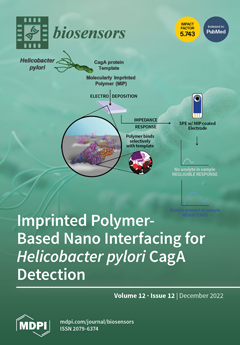Open AccessArticle
An Electrochemical Immunosensor Based on Carboxylated Graphene/SPCE for IgG-SARS-CoV-2 Nucleocapsid Determination
by
Luciana de Souza Freire, Camila Macena Ruzo, Bárbara Batista Salgado, Ariamna María Dip Gandarilla, Yonny Romaguera-Barcelay, Ana P. M. Tavares, Maria Goreti Ferreira Sales, Isabelle Cordeiro, Jaila Dias Borges Lalwani, Robert Matos, Henrique Fonseca Filho, Spartaco Astolfi-Filho, Ştefan Ţălu, Pritesh Lalwani and Walter Ricardo Brito
Cited by 5 | Viewed by 2137
Abstract
The COVID-19 pandemic has emphasized the importance and urgent need for rapid and accurate diagnostic tests for detecting and screening this infection. Our proposal was to develop a biosensor based on an ELISA immunoassay for monitoring antibodies against SARS-CoV-2 in human serum samples.
[...] Read more.
The COVID-19 pandemic has emphasized the importance and urgent need for rapid and accurate diagnostic tests for detecting and screening this infection. Our proposal was to develop a biosensor based on an ELISA immunoassay for monitoring antibodies against SARS-CoV-2 in human serum samples. The nucleocapsid protein (N protein) from SARS-CoV-2 was employed as a specific receptor for the detection of SARS-CoV-2 nucleocapsid immunoglobulin G. N protein was immobilized on the surface of a screen-printed carbon electrode (SPCE) modified with carboxylated graphene (CG). The percentage of IgG-SARS-CoV-2 nucleocapsid present was quantified using a secondary antibody labeled with horseradish peroxidase (HRP) (anti-IgG-HRP) catalyzed using 3,3′,5,5′-tetramethylbenzidine (TMB) mediator by chronoamperometry. A linear response was obtained in the range of 1:1000–1:200
v/v in phosphate buffer solution (PBS), and the detection limit calculated was 1:4947
v/
v. The chronoamperometric method showed electrical signals directly proportional to antibody concentrations due to antigen-antibody (Ag-Ab) specific and stable binding reaction.
Full article
►▼
Show Figures






